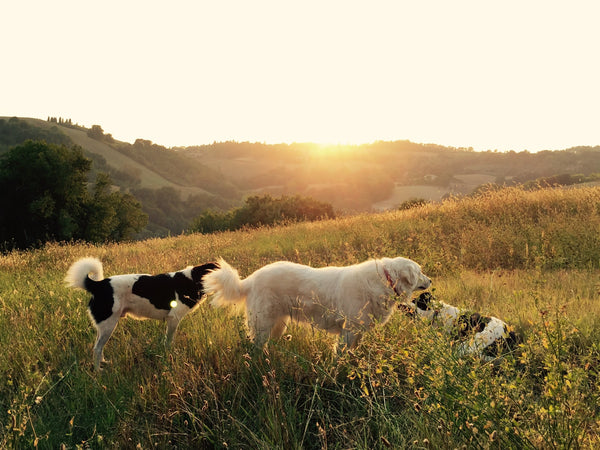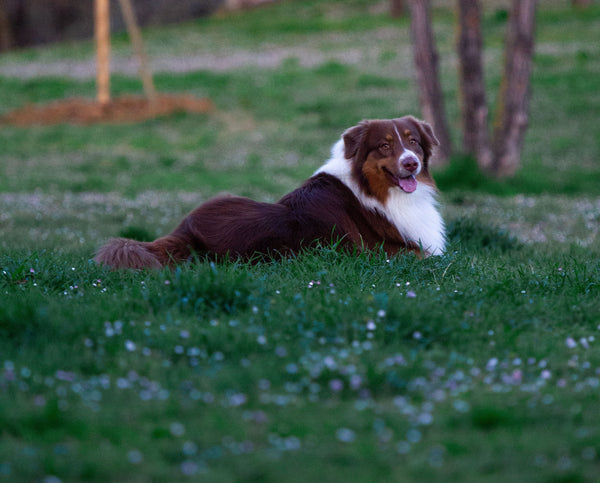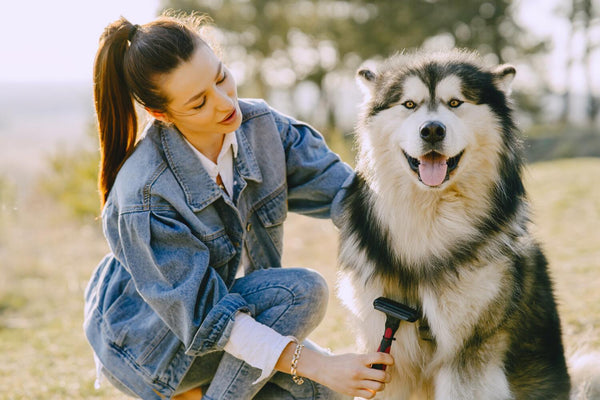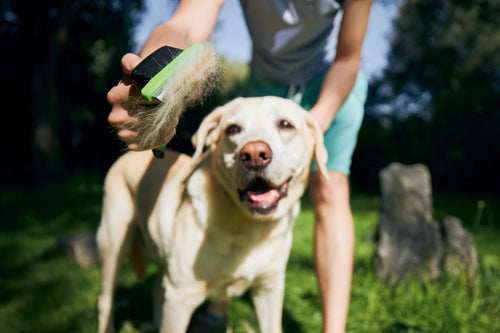When the weather starts to turn, it can cause our furry friends to start shedding their dog hair more than usual. Dogs shed more as seasons change- this is a common phenomenon and can be quite frustrating for a dog owner.
But don’t worry – there are several things you can do to help keep your pup’s coat healthy, remove dead hair and combat shedding. In this article, we’ll discuss seven tips to help keep seasonal shedding in check and keep your home fur-free.
What is Seasonal Dog Shedding?
Seasonal dog shedding is a natural process that occurs when the weather starts to change from warm to cold or vice versa. During these transitions, dogs can start shedding more frequently due to changes in their body temperature.
This increased shedding is normal and should not cause too much alarm; however, it can be a nuisance to pet owners. Depending on your dog's breed and your dog's coat type, you can expect a different amount of shedding. For example, short haired dogs tend to shed less than long haired breeds- especially those with an inner and outer coat.

Why it’s important to stay on top of seasonal shedding
It’s essential to take the right steps to ensure your dog’s shedding is kept under control. Failing to do so can lead to several issues in healthy dogs, including hair loss and skin problems.
Skin problems caused by poor shedding management can include bacterial and fungal skin issues, dermatitis (inflammation of the skin), and seborrhea (excessive oiliness of the coat).
Causes of Shedding
Seasonal shedding is a natural and normal part of a dog’s life cycle. Dogs and breeds shed differently depending on the season, and each breed will have its own unique shedding patterns.
Summer shedding
This type of dog shedding season is caused by the increased humidity and heat during the summer months. Dogs will shed more extensively to cool their bodies down and regulate their internal temperature.
Winter shedding
The cold weather causes a decrease in daylight hours, which results in a decrease in melatonin production. Melatonin helps regulate your dog’s coat growth cycle, so when there is less melatonin production, your dog’s coat will start to shed.
Fall shedding
The change in temperature during spring and fall can cause stress to your dog’s coat, which will trigger an increase in shedding. Additionally, the shorter days of autumn cause a decrease in daylight hours and melatonin production, leading to further shedding under control.
Spring shedding
Spring shedding is caused by changing temperatures and increased daylight hours. During this time, your dog’s coat will re-grow in preparation for the summer months.
What are other causes of shedding in dogs?
No matter what season it is, there can always be other factors that increase the amount of shedding in your dog. When paired with a high-shedding season, owners can be left taking care of quite the mess.
Other factors that can increase shedding are:
Poor nutrition
When the body lacks essential nutrients, it can lead to hair follicles becoming weak and brittle, resulting in excessive hair loss.
Additionally, inadequate nutrition can compromise the overall health of the skin and coat, making them more prone to shedding. It's essential to provide proper nutrition and a healthy diet to support the health of your hair and minimize shedding. Most owners start by supplementing their dog’s diet with omega-3s and other healthy oils.
Stress
Stress can increase shedding in several ways. When the dog's body is under stress, it releases a hormone called cortisol, which can disrupt the natural hair growth cycle. This disruption can lead to excessive shedding.
Additionally, stress can cause poor circulation to your dog's skin, depriving the hair follicles of essential nutrients and oxygen, further contributing to hair loss.
Mange
Mange, a common skin condition in dogs, can lead to excessive shedding. It is caused by mites infesting the dog's skin, resulting in itchiness, hair loss, and inflammation. The mites burrow into the dog's hair follicles and feed on the skin's oils, causing the dog to scratch and bite at affected areas, further exacerbating the shedding. If left untreated, mange can spread and cause severe discomfort for the dog.
Cushing's disease
Cushing's disease, also known as hyperadrenocorticism, is a condition that causes excessive production of cortisol in the body. This hormonal imbalance can lead to various symptoms, including hair loss or shedding. The increased cortisol levels can disrupt the normal hair growth cycle, resulting in thinning or loss of hair.
Additionally, the underlying mechanisms of Cushing's disease, such as inflammation and immune system dysfunction, can also contribute to hair shedding. Therefore, understanding the connection between Cushing's disease and shedding involves considering the complex interplay of hormonal, immune, and inflammatory factors that impact hair health.
Thyroid issues
Thyroid issues can cause shedding in dogs due to the disruption in their hormone levels. When the thyroid gland doesn't function properly, it can lead to an imbalance in the dog's metabolism, which in turn affects its hair growth cycle.
This imbalance can result in excessive shedding or hair loss. Dog owners need to monitor their pet's thyroid health and consult with a veterinarian to address any potential issues.
8 tips to keep shedding under control
Taking the right measures to control your dog’s shedding is important for its health and well-being, as well as reducing the amount of pet hair in your home.
Tip #1 Bathe Your Dog Regularly:
Regular bathing is not only a hygienic practice for pets, but it plays a crucial role in controlling shedding. By removing dirt, allergens, and loose fur, bathing helps maintain a clean and healthy coat.
Additionally, bathing promotes circulation, which can enhance the overall skin and coat condition of our furry friends. So, make sure to prioritize regular baths to keep your pet's shedding under control and their coat looking its best!
Tip #2 Brush Your Dog Regularly
Regular brushing is not only important for maintaining your pet's coat but also for effectively managing excess shedding. By brushing your pet regularly, you can remove loose and dead hair, preventing it from accumulating in your home.
Additionally, brushing stimulates the skin and promotes blood circulation, which can help keep your pet's skin healthy. Moreover, it provides an opportunity for bonding and can be a relaxing and enjoyable activity for both you and your furry friend. So, make brushing a part of your pet care routine and reap the benefits of a well-groomed and healthy companion!
Tip #3 Keep Your Dog Hydrated
Proper hydration is incredibly important for your dog's overall well-being. Not only does it help to keep them healthy and happy, but it also plays a significant role in reducing shedding. By ensuring that your furry friend is well-hydrated, you can promote a healthy coat and skin, minimizing excessive shedding.
Tip #4 Supplement with Omega-3 Fatty Acids
Discover the amazing benefits of incorporating omega-3 fatty acids into your dog's diet, and how these essential nutrients can not only help to control dog shedding but also promote a healthy coat and overall well-being.
With their natural anti-inflammatory properties, omega-3 fatty acids can support your furry friend's joint health, boost their immune system, and even enhance cognitive function. Give your dog the extra nutritional boost they deserve for a happier, healthier life!
Tip #5 Invest in Quality Grooming Products
Investing in high-quality shedding tools can have a significant impact on reducing shedding in your furry companions. By using specialized brushes and combs designed to effectively remove loose hair, you can minimize the amount of fur that ends up on your clothes, furniture, and floors.
Not only does this create a cleaner and more hygienic environment, but it also helps to maintain the overall health and appearance of your pets. With regular grooming sessions using a top-notch shedding tool, you can keep shedding at bay and enjoy a more enjoyable and hair-free living space.
Tip # 6 Avoid Allergens
Understanding how allergens contribute to seasonal shedding is crucial for pet owners. Allergens such as pollen, dust mites, and mold can trigger allergic reactions in pets, leading to excessive shedding. It's important to keep your furry friend away from these allergens to minimize discomfort and maintain their overall well-being.
Taking proactive measures, such as regular grooming, vacuuming, and keeping indoor air clean, can help reduce exposure to allergens and alleviate shedding issues. By being mindful of these factors, you can ensure a happier and healthier life for your beloved pet.
Tip #7 Visit Your Vet Regularly
Regular veterinarian visits are of utmost importance for the well-being of your furry companions. These visits not only provide routine check-ups and vaccinations but also play a crucial role in the early detection of any underlying health issues.
By closely monitoring your pet's health through regular vet visits, you can ensure their overall wellness and address any potential concerns before they escalate.
Conclusion
By following the above tips, you can ensure that your furry friend's coat stays healthy and under control throughout all seasons.
Additionally, it’s wise to monitor how much your pup is shedding, as this can indicate changes in their health. If you notice excessive shedding or other physical symptoms, don't hesitate to consult your veterinarian for further advice and treatment options. By taking the necessary measures to keep seasonal shedding under control, you can help ensure that your pup stays healthy and happy throughout all the seasons.






